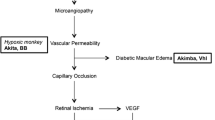Abstract
Diabetic retinopathy is a common complication of type 2 diabetes. Research into this comorbidity is challenging due to the slow progression of pathological changes and the limited transgenic models available to study disease progression and mechanistic changes. Here, we describe a non-transgenic mouse model of accelerated type 2 diabetes using a high-fat diet in combination with streptozotocin delivered via osmotic mini pump. This model, when subjected to fluorescent gelatin vascular casting, can be used to study vascular changes in type 2 diabetic retinopathy.
Access this chapter
Tax calculation will be finalised at checkout
Purchases are for personal use only
Similar content being viewed by others
References
Roglic G (2016) WHO global report on diabetes: a summary. Int J Noncommun Dis 1(1):3
Leasher JL, Bourne RR, Flaxman SR, Jonas JB, Keeffe J, Naidoo K, Pesudovs K, Price H, White RA, Wong TY (2016) Global estimates on the number of people blind or visually impaired by diabetic retinopathy: a meta-analysis from 1990 to 2010. Diabetes Care 39(9):1643–1649
Daniel A, Premilovac D, Foa L, Feng Z, Shah K, Zhang Q, Woolley KL, Bye N, Smith JA, Gueven N (2021) Novel short-chain quinones to treat vision loss in a rat model of diabetic retinopathy. Int J Mol Sci 22(3):1016
Premilovac D, Gasperini RJ, Sawyer S, West A, Keske MA, Taylor BV, Foa L (2017) A new method for targeted and sustained induction of type 2 diabetes in rodents. Sci Rep 7(1):14158
Southam K, Sousa C, Daniel A, Taylor BV, Foa L, Premilovac D (2022) Development and characterisation of a rat model that exhibits both metabolic dysfunction and neurodegeneration seen in type 2 diabetes. J Physiol 600(7):1611–1630. https://doi.org/10.1113/jp282454
Schnedl WJ, Ferber S, Johnson JH, Newgard CB (1994) STZ transport and cytotoxicity: specific enhancement in GLUT2-expressing cells. Diabetes 43(11):1326–1333. https://doi.org/10.2337/diab.43.11.1326
Yau JWY, Rogers SL, Kawasaki R, Lamoureux EL, Kowalski JW, Bek T, Chen S-J, Dekker JM, Fletcher A, Grauslund J, Haffner S, Hamman RF, Ikram MK, Kayama T, Klein BEK, Klein R, Krishnaiah S, Mayurasakorn K, O’Hare JP, Orchard TJ, Porta M, Rema M, Roy MS, Sharma T, Shaw J, Taylor H, Tielsch JM, Varma R, Wang JJ, Wang N, West S, Xu L, Yasuda M, Zhang X, Mitchell P, Wong TY (2012) Global prevalence and major risk factors of diabetic retinopathy. Diabetes Care 35(3):556–564. https://doi.org/10.2337/dc11-1909
Papanas N, Ziegler D (2015) Risk factors and comorbidities in diabetic neuropathy: an update 2015. Rev Diabet Stud 12(1–2):48
Dronavalli S, Duka I, Bakris GL (2008) The pathogenesis of diabetic nephropathy. Nat Clin Pract Endocrinol Metab 4(8):444–452
Claybon A, Bishop AJR (2011) Dissection of a mouse eye for a whole mount of the retinal pigment epithelium. J Vis Exp (48). https://doi.org/10.3791/2563
Arndt SS, Laarakker MC, van Lith HA, van der Staay FJ, Gieling E, Salomons AR, van’t Klooster J, Ohl F (2009) Individual housing of mice—impact on behaviour and stress responses. Physiol Behav 97(3–4):385–393
Acknowledgments
This work was supported by the University of Tasmania Research Enhancement Program grant.
Author information
Authors and Affiliations
Corresponding author
Editor information
Editors and Affiliations
Rights and permissions
Copyright information
© 2023 The Author(s), under exclusive license to Springer Science+Business Media, LLC, part of Springer Nature
About this protocol
Cite this protocol
Attrill, E., Richards, S.M., Ross, R.M., Sutherland, B.A., Premilovac, D. (2023). Induction of Type 2 Diabetes in Mice to Understand Vascular Changes That Drive Diabetic Retinopathy. In: Liu, GS., Wang, JH. (eds) Diabetic Retinopathy. Methods in Molecular Biology, vol 2678. Humana, New York, NY. https://doi.org/10.1007/978-1-0716-3255-0_1
Download citation
DOI: https://doi.org/10.1007/978-1-0716-3255-0_1
Published:
Publisher Name: Humana, New York, NY
Print ISBN: 978-1-0716-3254-3
Online ISBN: 978-1-0716-3255-0
eBook Packages: Springer Protocols




